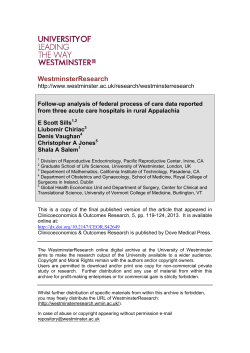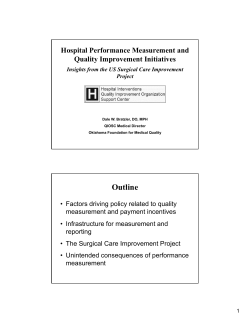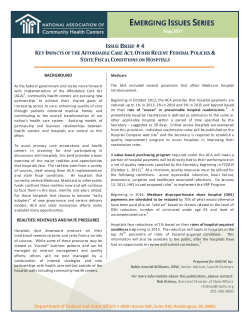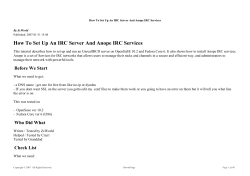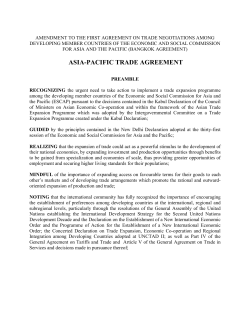
J. VIRTUAL MERGERS HOSPITAL JOINT OPERATING AGREEMENT AFFILIATIONS 1. Introduction
1997 EO CPE Text J. VIRTUAL MERGERS HOSPITAL JOINT OPERATING AGREEMENT AFFILIATIONS by Roderick Darling and Marvin Friedlander 1. Introduction The nonprofit healthcare industry in the United States is in the midst of significant change. A variety of different operational arrangements are being devised to achieve efficiencies and improve particular institutions’ financial health. Some of these arrangements, including the "virtual mergers" discussed in this article and "whole hospital joint ventures" of the sort arising between nonprofit and proprietary institutions, reflect substantial changes in the tax exempt entities’ operations. Agents examining institutions that have entered into such arrangments should ascertain whether the Service was notified of the change in operations as required by the terms of the standard IRS exemption determination letter and by Rev. Rul. 58-617, 1958-2 C.B. 260. Failure to notify the Service of significant changes in operations could have serious consequences for the exempt institution. Should adverse tax positions be taken by the Service, the presence or absence of notification would be significant for purposes of the effective date of the adverse action. 2. Background For some period of time, formerly independent exempt hospitals have been forming affiliations that are actual mergers, as evidenced by absolute structural and financial control ceded to a centralized "parent" entity, as in the following two situations. A. Northwestern Healthcare Network In an exemption ruling (administrative file is a matter of public record pursuant to IRC 6104) issued to Northwestern Healthcare Network, the central ized entity had the following powers: 1. Appoint and remove the members of the boards of the subordinates. 2. Approve amendments to the Articles or Bylaws of the subordinates. 3. Approve or disapprove withdrawal of subordinates from the system. Virtual Mergers - Hospital Joint Operating Agreement Affiliations 4. Monitor and audit the subordinates to assure compliance with its direc tives. 5. Authority over asset transfers, overall budgets and strategic plans, and capital acquisition strategies of the subordinates. 6. Direct or approve the mergers, acquisitions or affiliations of the subor dinates and their affiliates with other entities. B. PLRs 9609012 and 9623011 In PLRs 9609012 and 9623011 the Office of Assistant Chief Counsel (Finan cial Institutions and Products) relied on representations that a newly estab lished parent organization would constitute the sole governance authority of a network that included previously unrelated hospital systems and the Service concluded, in part, that services shared among the network’s participants were being performed as an integral part of the exempt activities of organizations that are financially and structurally related. These rulings reflect the interac tion between virtual mergers and the rules for tax exempt bonds under IRC 141. 3. Joint Operating Agreements Unlike the absolute financial and structural control affiliations previously described where a centralized authority has power over participating hospitals’ boards of directors and assets, regional hospital systems are now affiliating through a joint operating agreement that may be implemented through a partnership or through a non-profit corporation. The hallmark of the joint operating agreement type of affiliation is that participating hospitals retain their separate identities, boards of directors, and a certain amount of autonomy even though considerable management and financial authority is shifted to the governing body of the JOA. For example, authority to make moral or ethical decisions based on religious principles is usually retained by the hospitals. Powers ceded to the governing body of the joint operating agreement and powers reserved by the hospitals may be spelled out in a variety of documents, including a joint operating agreement, a partnership agreement, articles of incorporation, bylaws, a code of regulations, or management contracts. Because a joint operating agreement affiliation is not a true merger, it has come to be called a "virtual merger." Virtual mergers are intended to unify operations to achieve cost efficiencies necessary to compete successfully in a managed care environment by eliminat ing duplications, consolidating managerial decisions, and offering third-party payers unified access to cost effective services. 132 Virtual Mergers - Hospital Joint Operating Agreement Affiliations 4. What’s The Fuss? When an exempt hospital provides support activities that are not the direct provision of health care, such as management, fiscal, or administrative services, to exempt hospitals for a fee, it is usually subject to unrelated business income tax pursuant to IRC 511. This result is derived from IRC 513(e), which creates an exception to the unrelated trade or business rules for a hospital providing certain services listed in IRC 501(e) (e.g., data processing, billing and collection, or record center) but only if provided to exempt hospitals with facilities for less than 100 inpatients. Thus, ancillary services provided by an exempt organiza tion to other exempt organizations outside the IRC 513(e) exception are an unrelated trade or business. See also BSW Group, Inc. v. Commissioner, 70 T.C. 352 (1978). If this was the primary purpose of a healthcare organization, the provision of ancillary services for a fee to other exempt hospitals, then it would not be qualified for exemption since it would have a substantial nonexempt purpose. See Better Business Bureau v. United States, 326 U.S. 279, 283 (1945). Also, IRC 502 describes as a feeder organization one that is operated for the primary purpose of carrying on a trade or business for profit. A feeder organization is not qualified for exemption under IRC 501(a) on the grounds that all the profits are payable to exempt organizations. Moreover, where an organization is providing support activities on a centralized basis to hospitals, the exclusive route to exemption is generally provided by IRC 501(e), which provides exemp tion for certain cooperative hospital service organizations. See HCSC-Laundry v. United States, 450 U.S. 1 (1981). 5. Integral Part Basis For Exemption Even if an organization does not independently qualify for exemption, it may qualify if it is an integral part of an IRC 501(c)(3) organization, provided it is not a feeder organization within the meaning of IRC 502. An otherwise properly organized and operated organization could derivatively qualify for exemption as an integral part if (1) it performs essential services for an exempt organiza tion and the services, if performed by the exempt organization itself, would not be an unrelated trade or business, and (2) the exempt organization exercises sufficient control and close supervision, based on all the facts and circumstan ces, to establish the equivalent of a parent and subsidiary relationship. See Rev. Rul. 78-41, 1978-1 C.B. 148 (trust to satisfy malpractice claims against a hospital); Rev. Rul. 75-282, 1975-2 C.B. 201 (organization controlled by a conference of churches to provide member churches with mortgage loans); GCM 39830 (September 10, 1990) (a separately incorporated health maintenance 133 Virtual Mergers - Hospital Joint Operating Agreement Affiliations organization that was controlled by an exempt hospital was not providing essential services or services that would not be an unrelated trade or business if performed by the exempt parent necessary to satisfy the integral part basis for exemption); and GCM 39684 (December 10, 1987) (an organization was not qualified for exemption on the integral part basis where it performed services for an exempt parent organization and its subsidiary organizations as well as organizations that had no relationship to the parent). If the equivalent of a parent-subsidiary relationship is established, dealings between the parent and the subsidiary that would not otherwise have resulted in unrelated trade or business are considered to be merely a matter of account ing rather than unrelated trade or business activity under IRC 513. See Rev. Rul. 77-72, 1977-1 C.B. 157 (indebtedness owed to a labor union by its wholly owned tax-exempt subsidiary is not acquisition indebtedness within the mean ing of IRC 514 since the parent-subsidiary relationship shows the indebtedness to be merely a matter of accounting). 6. Application To Joint Operating Agreements Joint operating agreements between or among previously independent hospitals and hospital systems usually do not provide the "parent" authority over boards of directors and assets. Therefore, the Service must look for other explicit manifestations of control so dealings between the hospitals (and the parts of the hospital systems that are completely financially integrated) under the agreement are between organizations that are the equivalent of a parent and its subsidiary and thus not unrelated trade or business. If the hospitals establish a "super" parent to implement the joint operating agreement, and the facts and circumstances establish that the equivalent of a parent-subsidiary relationship exists, then the "super" parent will be considered to be an integral part of the subsidiaries. Thus, essential services it provides to the subsidiaries would not constitute unrelated trade or business. 7. Facts and Circumstances The following facts and circumstances provide the basis for a more flexible control analysis that does not rely strictly on the degree of structural control or on any one factor. Although some factors are more significant than others, the analysis looks to a preponderance of all the facts and circumstances that demonstrates significant control over management and financial decisions which have been ceded by participating entities to a governing body under a joint operating agreement or a "super" parent organization. There may be other 134 Virtual Mergers - Hospital Joint Operating Agreement Affiliations facts and circumstances that have not been listed and they too will be considered if raised by organizations. A. Delegation of Significant Authority The following facts and circumstances consider the long range and day-today management decisions delegated to the JOA governing body. In addition to specific items such as those set out below, the facts and circumstances also consider frequency of meetings by the JOA governing body and its overall responsibility for operational decisions. For example, if the JOA governing body meets infrequently merely to ratify a participating entity’s decision, it does not have authority to exercise significant management authority. Elements of specific management authority include: (1) Authority to establish budgets. This significant aspect includes respon sibility to establish overall budgets, as well as authority to approve major expenditures, debt, contracts, managed care agreements, and capital expenditures. This aspect also considers whether the JOA governing body regularly meets to establish long term and short term budgets and to implement its decisions. (2) Authority by the JOA governing body to monitor and audit each par ticipating entity’s compliance with its directives. This is a significant aspect. (3) Authority to direct services. This significant aspect considers whether the JOA governing body can direct that health care services be under taken or not be undertaken by the participating entities. For example, whether the governing body of the JOA can direct a participating hospital to refrain from being a provider of pediatric services. (4) Authority to enter agreements that bind participating entities, par ticularly agreements with managed care providers. (5) Authority to hire and fire personnel. (6) Authority to grant hospital staff privileges. (7) Authority to set or approve fees and prices. (8) Authority to buy assets for and sell assets of participating entities. (9) Authority to re-allocate income among the participating entities to balance income and expenses to assure financial integration and to achieve mutual objectives. 135 Virtual Mergers - Hospital Joint Operating Agreement Affiliations B. Permanence Factors that establish a permanent arrangement include whether there are significant penalties or other hindrances to terminating the agreement, and whether there are mechanisms such as direct negotiations and binding arbitra tion in place to resolve disputes among the parties. The degree to which the JOA is permanent also affects the determination whether the JOA establishes the equivalent of a parent-subsidiary relationship. C. Veto Power A veto power is not the same as a power to initiate an action. If the authority ceded to the JOA governing body is merely the power to veto actions taken by participating hospitals, then the facts and circumstances necessary to establish the equivalent of a parent-subsidiary relationship would not be present. Similarly, if actions of the JOA governing body are subject to veto by the participating hospitals, this too would negate a finding that the hospitals function as subordinates of the JOA. D. Reserved Powers If participating hospitals retain some authority, this is not necessarily determinative of whether the equivalent of a parent-subsidiary relationship has been established. For example, authority over ethical or moral issues based on religious principles may be reserved by the participating entities. If all of the other surrounding facts and circumstances showed that sufficient authority had otherwise been ceded to the JOA governing body, this type of reservation would not preclude a finding that the equivalent of a parent-subsidiary relationship had been established. E. Less Than Full Integration Where there is not full integration among participating hospitals because, for example, a hospital system excludes one or more of its subsidiary hospitals from participating in the joint operating agreement, then services involving the excluded organization would not be covered by the joint operating agreement and may not be excepted from unrelated business income tax. 136 Virtual Mergers - Hospital Joint Operating Agreement Affiliations 8. Conclusion This is a new and evolving area for tax exempt hospitals. Certainly, we will be continuing to look closely at transactions that involve joint operating agree ments or other forms of affiliations between exempt hospitals. Private Letter Rulings (PLR) in this area involving unrelated business income tax issues will be available to the public under IRC 6110. They will reflect application of these tax law considerations to specific factual situations. 137
© Copyright 2025









